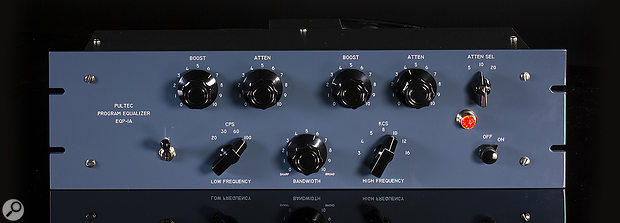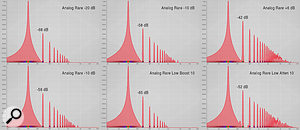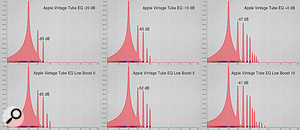 The original and best? EQP‑1A equalisers are once again being made under the Pulse Techniques brand.
The original and best? EQP‑1A equalisers are once again being made under the Pulse Techniques brand.
Plug‑in models of classic hardware can sound great if you feed them the right level. But what level is right?
Like the real thing, plug‑in models of the famous Pultec EQP‑1A can add a unique character to your mixes. The silky high band polishes the top end in a way that's nothing like the sound of your DAW's built-in EQ. A little bit of low boost causes kick drum and bass to really be felt, rather than just heard.
If you're like me, though, you may have found that certain Pultec plug‑ins sometimes don't sound right. It turns out that there is a reason for this — and it's down to the way different plug‑ins respond to input level. Some plug‑ins need to be hit hard in order to bring out their mojo, while feeding the same level to others causes extreme distortion!
Am I Hot Or Not?
In a hardware Pultec, valves, transformers and other electronic components all contribute distortion, which shows up in the output as newly created overtones. By adjusting the input level of a vintage unit, you can determine the exact amount of coloration.
The same is true of most Pultec plug‑ins — but the vast majority of them do not have an input gain control. This means that the amount of coloration is determined simply by the level coming into the plug‑in. If that signal is too hot, too many overtones will be generated. Distortion will cause the mids and highs to sound harsh, and the low frequencies of kick and bass will be augmented by unwanted lower-mid harmonics. This will add a 'gargling' quality to the music, causing those instruments to shrink in size. Not something to look forward to!
So, the key to getting the best from Pultec plug‑ins is to manage the level going into them. And this is where the problem arises, because it turns out that different Pultec plug‑ins respond very differently to input level. Many of them produce distortion that varies proportionally with input level, but in others, there's a threshold above which distortion dramatically increases. And that's not all: some of them, quite unexpectedly, produce less distortion with hotter signals, and some introduce no distortion at all!
Six Of The Best
For my tests, I analysed some of the most popular Pultec-inspired plug‑ins: Waves' PuigTec EQP‑1A, Universal Audio's Pultec EQP‑1A and EQP‑1A Legacy, Softube's Tube‑Tech PE-1C, the Vintage EQ in Apple's Logic Pro and Analog Obsession's free Rare, along with UA's recreation of the more modern Manley Massive Passive.
 Testing was done in Logic 10.4.8 at a sample rate of 44.1kHz. Each plug‑in was fed a pure 100Hz sine wave at various levels. The output spectrum was plotted in an FFT diagram with the help of Melda Productions' MAnalyzer version 9.22. Finally, I checked the effect of boosting the lows on the overtone spectrum. Note that this shootout is not meant as an exhaustive technical test, but rather to give you a feel of the sound and behaviour of each plug‑in. Even with the Boost/Attenuate knobs at zero, most of them produced a basic amount of distortion even with the bypass switch set to Off, confirming the popular belief that the Pultec should do something to the sound even with the EQ not active.
Testing was done in Logic 10.4.8 at a sample rate of 44.1kHz. Each plug‑in was fed a pure 100Hz sine wave at various levels. The output spectrum was plotted in an FFT diagram with the help of Melda Productions' MAnalyzer version 9.22. Finally, I checked the effect of boosting the lows on the overtone spectrum. Note that this shootout is not meant as an exhaustive technical test, but rather to give you a feel of the sound and behaviour of each plug‑in. Even with the Boost/Attenuate knobs at zero, most of them produced a basic amount of distortion even with the bypass switch set to Off, confirming the popular belief that the Pultec should do something to the sound even with the EQ not active.
Waves PuigTec EQP1A
There's no need to hit this Pultec hard if it's extra coloration that you're after: as you can see from the top three graphs, distortion increases only slowly with increased input level. Above 0dB, this increase actually slows down a bit. In other words, high input levels are no problem for the PuigTec, and beyond a certain point, turning the input up does not yield much extra distortion. In comparison with the other plug‑ins, its harmonics are not only louder, but they also appear high in the spectrum, perhaps causing it to sound a bit more vibrant and brighter than others.
Turning up the PuigTec's low shelf at 100Hz causes distortion to change proportionally with the amount boosted (bottom three graphs).
Universal Audio Pultec EQP‑1A
 This Pultec's distortion behaviour is quite different from that of Waves' offering. First, it produces noise in the high frequencies, though at -110dB, that's nothing to be concerned about. At a -10dB input level, the UAD produces little distortion, but as you raise the level, the unit quickly comes alive, especially in terms of generating third harmonics. Beyond 0dB, the increase of overtones slows down a bit — but be careful with high levels, because at +7dB the plug‑in will start producing excessive distortion. If it's coloration that you're after, you should hit this baby hard, although the sound will always be a bit cleaner than the PuigTec.
This Pultec's distortion behaviour is quite different from that of Waves' offering. First, it produces noise in the high frequencies, though at -110dB, that's nothing to be concerned about. At a -10dB input level, the UAD produces little distortion, but as you raise the level, the unit quickly comes alive, especially in terms of generating third harmonics. Beyond 0dB, the increase of overtones slows down a bit — but be careful with high levels, because at +7dB the plug‑in will start producing excessive distortion. If it's coloration that you're after, you should hit this baby hard, although the sound will always be a bit cleaner than the PuigTec.
UA's Pultec reacts in a similar dynamic fashion when boosting the low shelf, with third and higher harmonics again becoming prominent at higher levels.
Universal Audio Pultec EQP‑1A Legacy
Like other Legacy plug‑ins from UAD, which are optimised for low DSP load, this EQ doesn't add any distortion to the input signal, and can be used safely on very high input levels.
Analog Obsession Rare
 How does a free plug‑in compare to commercial options? Well, even on conservative input levels, Rare adds quite a lot of distortion to the signal. Pushing it further causes distortion to increase proportionally, but note the absence of the second harmonic (at 200Hz)! Also noteworthy is that unlike the other plug‑ins, Rare doesn't colour the signal when the On/Off switch is set to Off.
How does a free plug‑in compare to commercial options? Well, even on conservative input levels, Rare adds quite a lot of distortion to the signal. Pushing it further causes distortion to increase proportionally, but note the absence of the second harmonic (at 200Hz)! Also noteworthy is that unlike the other plug‑ins, Rare doesn't colour the signal when the On/Off switch is set to Off.
The really surprising results from this plug‑in, though, relate to the low shelf. Boosting at 100Hz actually causes the overtones to progressively decrease in level, while attenuating causes them to become louder! Although this may sound counter-intuitive, it could actually work to your advantage. The boost behaviour helps to focus the boost by not enhancing surrounding frequencies, and the effect of cutting at one frequency may be more audible if the plug‑in starts adding harmonics in other areas.
Softube PE 1C
 Softube's plug‑in is based not on the original Pultec equaliser but on the more modern version of it made by Tube‑Tech. Its distortion behaviour is a little different from the rest. First, there are no even harmonics in the output spectrum, just odd harmonics (for a 100Hz input, this means 300Hz, 500Hz and so on). Upping the input level from -20dB to -10dB causes a slight increase in fifth harmonic and higher overtones, while the third (loudest) harmonic stays where it is. Towards 0dB, the overtone spectrum contracts slightly and this behaviour continues towards +24dB, which is where I stopped measuring.
Softube's plug‑in is based not on the original Pultec equaliser but on the more modern version of it made by Tube‑Tech. Its distortion behaviour is a little different from the rest. First, there are no even harmonics in the output spectrum, just odd harmonics (for a 100Hz input, this means 300Hz, 500Hz and so on). Upping the input level from -20dB to -10dB causes a slight increase in fifth harmonic and higher overtones, while the third (loudest) harmonic stays where it is. Towards 0dB, the overtone spectrum contracts slightly and this behaviour continues towards +24dB, which is where I stopped measuring.
As on Rare, boosting at 100Hz actually causes distortion to decrease slightly.
Apple Logic Pro Vintage Tube EQ
 Even with the Drive setting at 0, Apple's Pultec produces quite some mojo. It is also one of the most dynamic plug‑ins, especially if you consider the third harmonic. You're safe from excessive distortion until the input reaches +12dB, although I suspect not many professionals are running levels like that. Vintage Tube EQ also reacts vigorously when boosting 100Hz!
Even with the Drive setting at 0, Apple's Pultec produces quite some mojo. It is also one of the most dynamic plug‑ins, especially if you consider the third harmonic. You're safe from excessive distortion until the input reaches +12dB, although I suspect not many professionals are running levels like that. Vintage Tube EQ also reacts vigorously when boosting 100Hz!
Universal Audio Manley Massive Passive
 Although not a Pultec, Manley's Massive Passive is largely inspired by it — Manley call it an "improved" Pultec, and it has been a favourite in mastering applications for more than two decades now.
Although not a Pultec, Manley's Massive Passive is largely inspired by it — Manley call it an "improved" Pultec, and it has been a favourite in mastering applications for more than two decades now.
Regardless of the position of Massive's per-band Boost-Cut On/Off-knobs, UAD's software version appears to have a strong liking for second- and third-order harmonic distortion, while leaving the rest of the spectrum alone. The second-harmonic overtones change proportionally with signal level, while the third-harmonic level reacts more actively. Be cautious with high signal levels here: while an input signal of +5dB may sound pristine, upping that value just 1dB causes extreme distortion!
The Massive Passive's reaction to boosting 100Hz can truly be called 'explosive': the spectrum quickly fills up with a wide range of loud harmonics. When switching to Cut instead of Boost, the overtone volume decreases but the plug‑in still produces a lot of distortion!
Out of curiosity, I compared UAD's Manley plug‑in to a hardware Massive Passive, and it appeared that the shape of UAD's overtone spectrum is actually very similar to that of its hot-running real-life counterpart. With all EQ gains set at zero, the software version can be quite a bit dirtier, but once you start boosting, the differences become smaller, to the point where the plug‑in is only slightly dirtier than the hardware.
I compared UAD's Manley plug‑in to a hardware Massive Passive, and it appeared that the shape of UAD's overtone spectrum is actually very similar to that of its hot-running real-life counterpart.
The Real Deal
With Pultec EQs, it's impossible to say which plug‑in is most true to the original. That's because developers base their models on a chosen 'golden unit' which is different in each case, so there is no one 'true' original. The electronic components in these units may have degraded through the years, and may have started to perform outside specification.
Even so, it's clear that each developer has had to make a decision about how distortion levels in the plug‑in should change with input level, or with EQ moves. There is no wrong or right here, because they're all doing their best to translate the behaviour of the hardware into a software environment in the way that they think will be most useful. But it is important to know how your specific Pultec plug‑in behaves in order to get the best from it.
What's clear above all is that every Pultec EQ requires precise levelling in the mixer and proper gain staging. Anyone who wants to top off an existing signal chain with a touch of Pultec EQ should adjust the output level of the preceding plug‑in to optimise the amount of saturation that's being produced in their Pultec plug‑in of choice. Note that this is especially true when you're using a Pultec on the mix bus! (If the Pultec is the first or only plug‑in in the chain, insert a Trim, Utility or Gain plug‑in before it to trim the level.)
If you're lucky enough to have multiple Pultec models at your disposal, you could even use the information in this article to help you, for instance, select a dirtier Pultec for the bass and the vocal, and a cleaner model on the mix bus. Finally, note that distortion that is not obvious in isolation can quickly become audible when you later compress the signal!
Hans Weekhout's Music Production: Learn How To Record, Mix And Master Music is published by Focal Press.
Manufacturers' Comments
Softube say that they precisely modelled a 'golden unit' that was given to them by John G Petersen, who owns the Tube‑Tech company and designs their hardware. As Petersen has always been an advocate of a clean-sounding Pultec, Softube closely followed his philosophy, saying "The PE 1C is not a dirty-sounding tube equaliser, and nor was the Pultec. It's only after years of service that components wear out, and units start to produce extra distortion."
Waves tell me that PuigTec's distortion was modelled after a golden unit owned by Jack Joseph Puig, which "had processed numerous hits, and was meticulously maintained by the best industry technical engineers at Ocean Way Studios". After endless listening, the particular distortion character of this Pultec was recreated in a custom-built 'harmonics unit'. The profile from this harmonics unit was then transferred into the final software.
High Shelves
I also tested the high shelving band on all the plug‑ins to understand the resulting distortion behaviour. As the graphs would take up too much space, they are not included with this article, but what I can say is that the behaviour of high shelf EQs was (very) similar to their low shelf. Softube's PE 1C was an exception, as the high shelf on this unit is totally free from distortion. So no extra coloration will take place once you start adding highs with the Tube‑Tech.
Different Pultecs, Different Behaviour!
This table compares the distortion behaviour of popular Pultec EQ plug‑ins, based on an average input signal of -10dB, and the low shelf boost set at 5 (halfway). The higher the ranking, the more 'mojo'.
|
Mojo level |
Plug‑in |
Level increase causes distortion to |
Boosting causes distortion to |
Excessive distortion at |
|
1 |
Waves PuigTec EQP‑1A |
increase proportionally |
increase proportionally |
>24dB |
|
2 |
Apple Logic Pro Vintage Tube EQ |
increase progressively |
increase very progressively (especially odd harmonics) |
+12dB |
|
3 |
UAD Manley Massive Passive |
increase progressively |
increase explosively (especially odd harmonics) |
+6dB |
|
4 |
Analog Obsession Rare |
increase proportionally |
decrease proportionally |
>24dB |
|
5 |
Universal Audio Pultec EQP‑1A |
increase progressively |
increase progressively (especially odd harmonics) |
+7dB |
|
6 |
Softube Tube‑Tech PE 1C |
increase slightly |
decrease proportionally |
>24dB |
|
7 |
UAD Pultec EQP‑1A Legacy |
-- |
-- |
>24dB |
